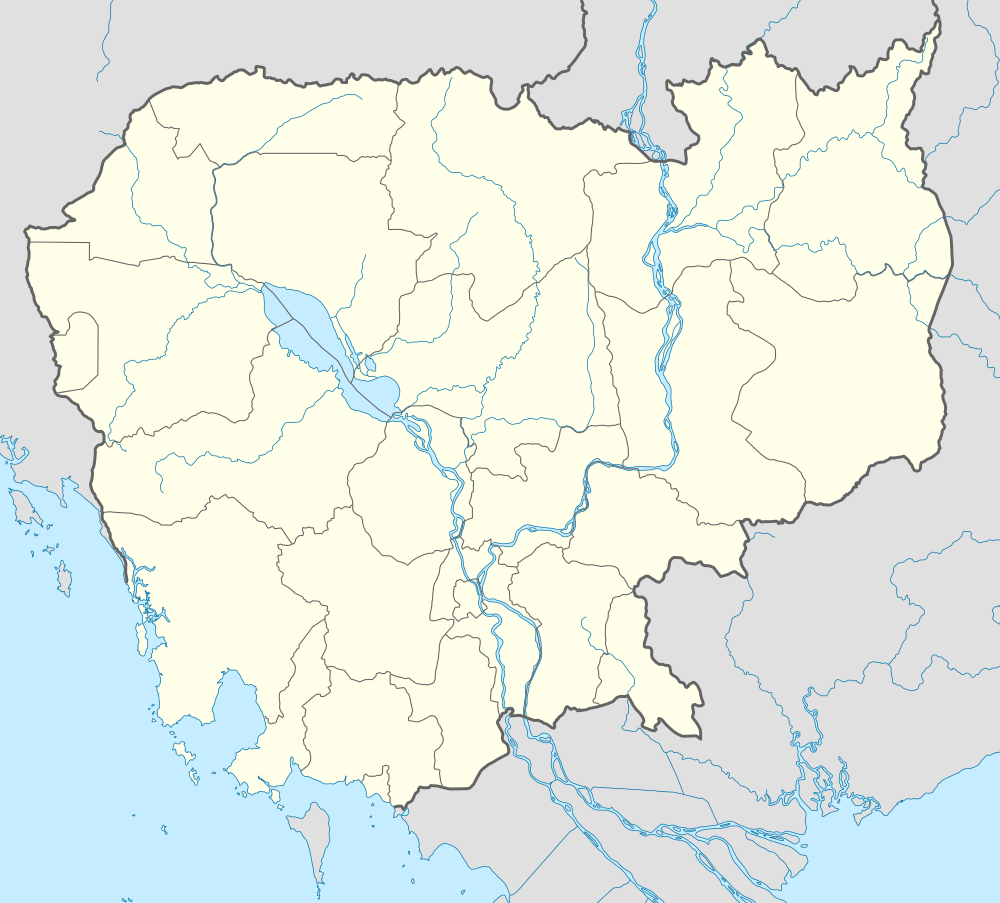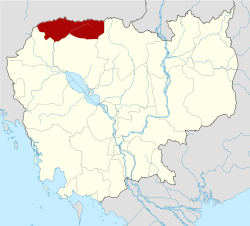Anlong Veng District
| Anlong Veng អន្លុងវែង | |
|---|---|
| District (srok) | |
 Anlong Veng Location in Cambodia | |
| Coordinates: 14°14′N 104°05′E / 14.233°N 104.083°E | |
| Country |
|
| Province | Oddar Meanchey |
| Time zone | +7 |
| Geocode | 2201 |
Anlong Veng District (Khmer: ស្រុកអន្លុងវែង) is a district in Oddar Meanchey province in Cambodia. The main town in the district is also called Anlong Veng. The population of the district could not be counted during the 1998 census of Cambodia due to ongoing conflict during the time of the census.[1]
Geographic data
Anlong Veng is in the area of the Dângrêk Mountains, in the far north of Cambodia. It is located 125 km north of Siem Reap and close to the international border crossing with Thailand. There is a dam just north of the town.
History
Anlong Veng is best known for two historical reasons. It was the last stronghold of the Khmer Rouge to come under government control in 1998 and the final resting place of Pol Pot.
The Dângrêk Mountains were used as a base by the Khmer Rouge when they fought against the Khmer Republic led by general Lon Nol.
After the end of the Vietnamese occupation of Cambodia and the withdrawal of the Vietnamese army, the Khmer Rouge rebuilt their former bases in the Dangrek mountain range area, along the border of Cambodia. Anlong Veng became for a while the main "capital" of the Khmer Rouge. In the 1990s the Khmer Rouge still controlled Anlong Veng, where there was one of the first "Killing Fields" after the fall of "Democratic Kampuchea".
There is a still not excavated site in a forest with landmines in the Dângrêk Mountains, located about 6 km out of Anlong Veng where 3,000 people were allegedly killed by the Khmer Rouge for having become "corrupted" as late as between 1993 and 1997. These executions were carried out during Ta Mok's leadership in the area.[2]
Development
Prime-minister Hun Sen's Historical Restoration Initiative circular (Dec 2001) called for the site at Anlong Veng to become a memorial and tourist site in time for the Visit Cambodia year in 2003. The town is seen by the government as a useful stopping point for tours from Siem Riep to the 11th-century temples at Preah Vihear. The site has had minor tourist developments including museums, hotels and a proposed casino.
References
- ↑ "General Population Census of Cambodia 1998, Final Census Results". National Institute of Statistics, Ministry of Planning, Cambodia. August 2002. Retrieved 2010-11-25. See page 271.
- ↑ Kelvin Rowley, Second Life, Second Death: The Khmer Rouge After 1978
External links
- History and Development
- General Information
- Recent travel reports
- Government circular on preserving KR sites
Coordinates: 14°14′N 104°05′E / 14.233°N 104.083°E
| ||||||||||||
| ||||||||||||
